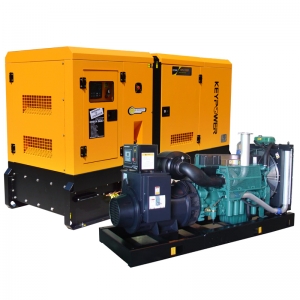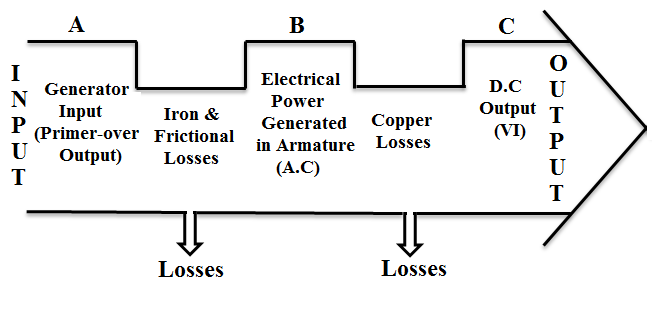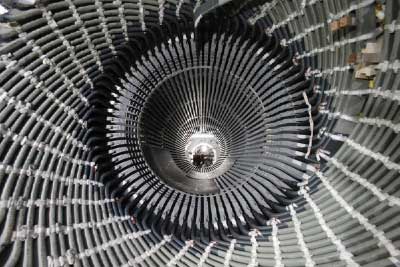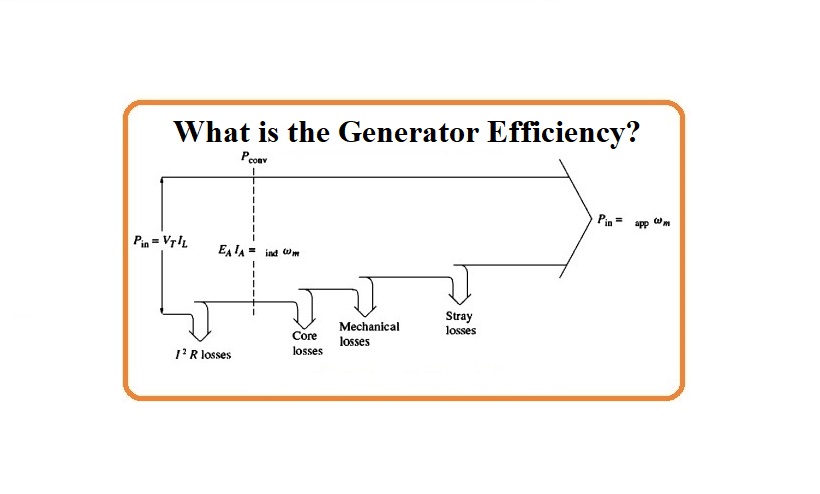Generator Efficiency- A generator is a machine that converts mechanical energy to electric power. Its efficiency is defined as the ratio of electrical power output to mechanical power input. The ratio of the net shaft work production of the turbine to the heat input to the working fluid is commonly characterized as the thermal efficiency of a power plant, which is of major interest in thermodynamics. Other aspects are taken into account by defining the total efficiency as the ratio of net electrical power production to the rate of fuel energy input.
The power of the load circuit and the total wattage produced by the generator are what define a generator’s efficiency. Since you are dividing units of power by units of power, it is stated as a percentage. For the majority of commercial electricity generators, this ratio may reach 95%. Generators are available from a variety of Suppliers and Companies, as well as various manufacturers and distributors, and there are many Generators for Sale on Linquip.
A comprehensive list of generator services is available on the Linquip website, which covers all OEM fleets. Linquip vendors can assist you with this. To learn more about how to connect with a wide range of service providers who consistently provide the highest quality goods, please contact Generator Experts on Linquip.
What is Generator Efficiency?
The machines that convert the rotating motion of a prime mover into electricity, known as power plant generators, are rarely in the news. While developments in gas turbine and combined cycle design have made it possible to achieve efficiencies of over 60%, and steam turbine researchers are aiming for 50%, the generator that produces the electrical output from each of these plants is scarcely mentioned. Despite its unnoticed status, this component has a mechanical-to-electrical conversion efficiency of about 100%.

When it comes to headlines, this incredible efficiency is part of the problem. While improvements in thermodynamic cycle design may result in a 0.1-0.2 percentage point increase in overall system efficiency, similar levels of development in generator design — for example, an improved magnetic material, advances in insulating tape, or optimization of cooling fluid flows — will struggle to find an additional 0.1-0.2 percentage point improvement.
Even a major technological breakthrough, such as the incorporation of high-temperature superconducting materials into generator windings, is only likely to deliver a 0.2-0.4 percentage point improvement. Given that this is expected to result in an efficiency of over 99 percent, such low yields are somewhat unsurprising.
Decades of development have resulted in this remarkable efficiency. As Dr. Thorsten Krol, manager of Siemens’ generator business development with responsibility for technical marketing of generators in the company’s Power and Gas division, pointed out, the classic generator design in use today is over 140 years old, and the efficiency is close to the maximum achievable. “You are at the technological limit with available technologies,” he remarked.
Finding ways to increase performance, even if just a little, is challenging when ideas have been improved over such a lengthy time. Even so, a minor improvement here and there is still achievable. Any improvement, however, comes at a price, and that price may be too great to justify. As a result, advanced generator design is a balancing act in terms of cost.
Are Generators 100% Efficient?
However, no electric motor is 100% efficient. Heat, noise, and the creation of products like carbon dioxide all result in energy loss. A generator is 70 percent efficient if it produces 700 watts out of a 1000-watt generator.
What Is the Maximum Efficiency of a Generator?
A DC generator operates at its most efficient level when its losses are proportionate to the square of the load current. The DC generator’s variable losses are equivalent to its constant losses, i.e., armature circuit loss is equal to the sum of field circuit loss and no-load rotational loss.
How to Calculate an Electrical Generator Efficiency
When an electrical generator loses power, its efficiency falls below 100%. The power of the load circuit and the total watts produced by the generator influence the generator’s efficiency. Because you’re dividing units of power by units of power, it’s expressed as a percentage. This ratio can be as high as 95% for most commercial electricity generators. The losses are typically caused by the transformer, copper windings, magnetizing losses in the core, and the generator’s rotational friction.

- Calculate how much fuel the generator consumes in an hour. A diesel fuel consumption chart can be used to calculate how much fuel generators of various sizes use in an hour.
- Calculate the total amount of electricity used in an hour. This can be performed by connecting a kilowatt-hour meter to the generator’s output or referring to the generator’s electrical output label.
- Convert the amount of fuel consumed into BTUs (British Thermal Units). The quantity of BTUs in various types of fossil fuels is charted by the Oak Ridge National Laboratory.
- Use the conversion factor of 1 kWh = 3413 BTU to convert the BTU value of the fuel to kilowatt-hours.
- Subtract the generator’s output in kWh from the fuel’s input value. To convert this amount to a percentage, multiply it by 100.
The Cooling Problem
One of the most difficult aspects of generator design is removing heat from the rotor and stator coils. One of the major parameters that a generator designer has is how and with what he or she does it. Air, hydrogen, and water are the three primary cooling media for generators. Each has its own set of benefits and drawbacks.
Large generators are manufactured to fulfill the IEC standard, which sets a maximum temperature of 155oC during operation, and components are designed to tolerate this temperature. However, it is common for them to be constructed to not surpass a lower temperature, often 130oC, to provide some thermal reserves in the event of an overload and/or to extend the machine’s lifetime.
Water is used to get the best cooling efficiency. This is 50 times more efficient than air and more than ten times more efficient than hydrogen cooling, but it is even more difficult to install. As a result, it’s only found in the biggest generators. When water cooling is employed, it is used to cool the generator’s stator, whereas hydrogen cooling is used to cool the rotor.
The sort of cooling utilized in a generator is determined by the size and type of the generator. While the cross-over points vary by manufacturer, for typical fossil fuel generators, air cooling can be used up to roughly 300–350MW, hydrogen cooling up to 550MW, and a combination of water and hydrogen cooling up to 500MW.
Material Changes
Reducing electrical losses in the generator coils and magnetic losses in the stator core are two other major areas where benefits can be made. It’s all about the materials when it comes to reducing electrical and mechanical losses. By lowering the coil resistance, electrical and resistive losses in the coil windings can be reduced. This is accomplished by increasing the copper content of the coils.
Meanwhile, utilizing higher-grade silicon steel in the stator core helps reduce magnetic losses. Steel is evaluated based on how much it loses in a typical test that uses a 50 Hz and 1.5 Tesla magnetic field. For common grades, the loss per kg is between 2 and 5.3 W. The lesser the loss, the higher the steel quality (and the more expensive it is). The stator core can also be made lighter by adopting thinner steel laminations. Grain-oriented steels can also be advantageous, but they must be utilized with caution or they will produce the reverse effect. Here, you can see the effect of materials on the generator’s efficiency.

The difficulty with all of these strategies is that they enhance the generator’s cost – as Hildinger pointed out, an accurate cost evaluation of each measure is required to ensure that it is cost-effective. It is feasible to compute the increase in output from a large generator as a result of using better steel or more copper, as well as the cost of the change, yielding a cost/kW for each improvement. If this is less than the price the generator owner will earn for each kW of electricity sold, the upgrades are worthwhile; otherwise, they are not.
This will be determined by market conditions. Higher-spec materials can be cost-effective in places where the cost of electricity is high, but elsewhere they often are not.
The use of high-temperature superconductors is a more significant material modification in generator design. Within ten years, according to Dr. Krol, the use of these could be a reality. He did point out, however, that while the materials have low coil resistance, they aren’t particularly well-suited for usage in generators with frequent output variations. For all major generators, this form of operation is becoming increasingly significant. Facilities such as gas turbines, steam turbines, and hydropower plants are expected to operate in far more flexible ways than previously required.
The New Renewables Question
The introduction of substantial volumes of power from variable-output wind and solar power plants into grids has resulted in this new paradigm. Traditional fossil and hydro facilities, which were formerly used primarily for baseload generation, must now accommodate the additional renewable input. As a result of this adjustment, the generator design is changing.
Generator cycling has an impact on all aspects of machine design. The winding of the generator, for example, will undergo thermal cycling as a result of frequent fluctuations in output. This will hasten the aging of the insulation, as well as the mechanical aging of moving components, such as wear and fatigue. As a result, generators utilized in these settings must be modified to withstand the new stresses they are subjected to.
Hildinger also saw an increase in the utilization of hydropower units as peaking plants. This is due to the need to encourage new renewable capacity, with hydropower being one of the most cost-effective ways to do so. As a result, designers of hydropower generators have begun to consider variable-speed machines, especially for pumped storage applications.
Variable speed generators are more expensive than traditional generators, making them uneconomical in most markets. However, in countries like Japan and Europe, where the cost of power is high and grid support services may generate revenue, their use is becoming increasingly cost-effective. The actual spinning of the turbine generator is isolated from the grid frequency using power electronics in a variable-speed generator. This permits turbine speed to be adjusted according to hydraulic conditions, enhancing total turbine-generator efficiency and providing more grid support flexibility.
Aside from the fluctuation, one of the most important side effects of integrating large volumes of solar and wind power into a grid is a decrease in total system inertia. The spinning machinery in a grid populated by conventional power plants has substantial rotational inertia, which can keep the grid stable in the case of a major change in grid circumstances while the grid operator works to fix the change. A four- to five-second inertia-supported period exists for a conventional grid during which adjustment can be undertaken.
Because modern renewable plants have significantly less inertia, the grid is more likely to become unstable after a major event. To combat this, it may be essential to boost the inertia of the grid’s remaining huge rotating machinery.
Adapting the design of generators is one technique to increase inertia. There are two main approaches to accomplish this. The first step is to expand the generator rotor’s diameter. However, the maximum rotating force that the materials can withstand limits the amount of this, particularly in hydro machines. The second option is to raise the rotor’s mass, which will result in a higher cost. Although such modifications are not yet a part of generator design, the fact that they are being discussed demonstrates how important generator advancements remain.
Download Generator Efficiency PDF
Buy Equipment or Ask for a Service
By using Linquip RFQ Service, you can expect to receive quotations from various suppliers across multiple industries and regions.
Click Here to Request a Quotation From Suppliers and Service Providers
Read More on Linquip
- Generator Maintenance: The Most Essential Tips to Know
- The Difference Between Generator and Inverter: All You Need to Know
- Types of Generators: Learn the Basics, Get the Most Out f it!
- Efficiency of Diesel Generators
- Concise Guide to Generator Transfer Switch Installation Cost in 2022
- Working Principle of AC Generator
- Synchronization of Generators: Step-by-Step Guide + PDF
- Electric Heater Efficiency and Running Costs
- Efficiency of Fuel Cell: Calculation Formula & Equation
- Space Heater Efficiency For Various Types of Heater
- Heater Efficiency Calculation: Formula & Equation
- Fan Efficiency Calculation: Formula & Equation
- DC Motor Efficiency: Calculation: Formula & Equation
- Efficiency of Diesel Generators Calculation: Formula & Equation
- Calculation of Pump Efficiency: Formula & Equation
- Energy Efficient Electric Heater: A Practical Guide
- Efficiency of Inverter: Calculation & Equation Guide
- Efficiency of Induction Motor: Calculation & Equation



